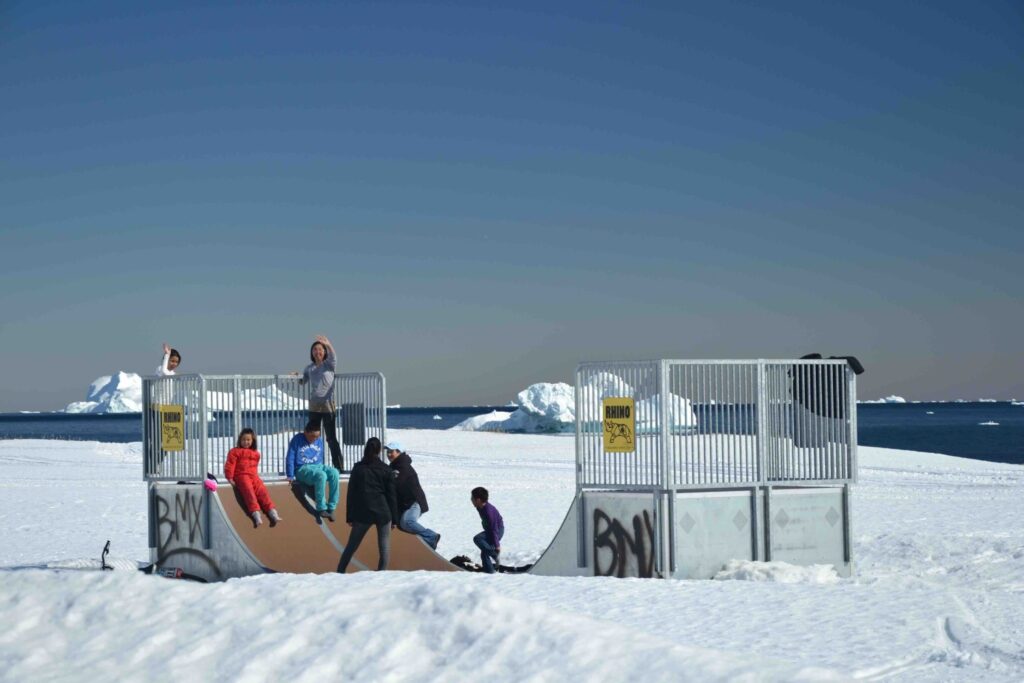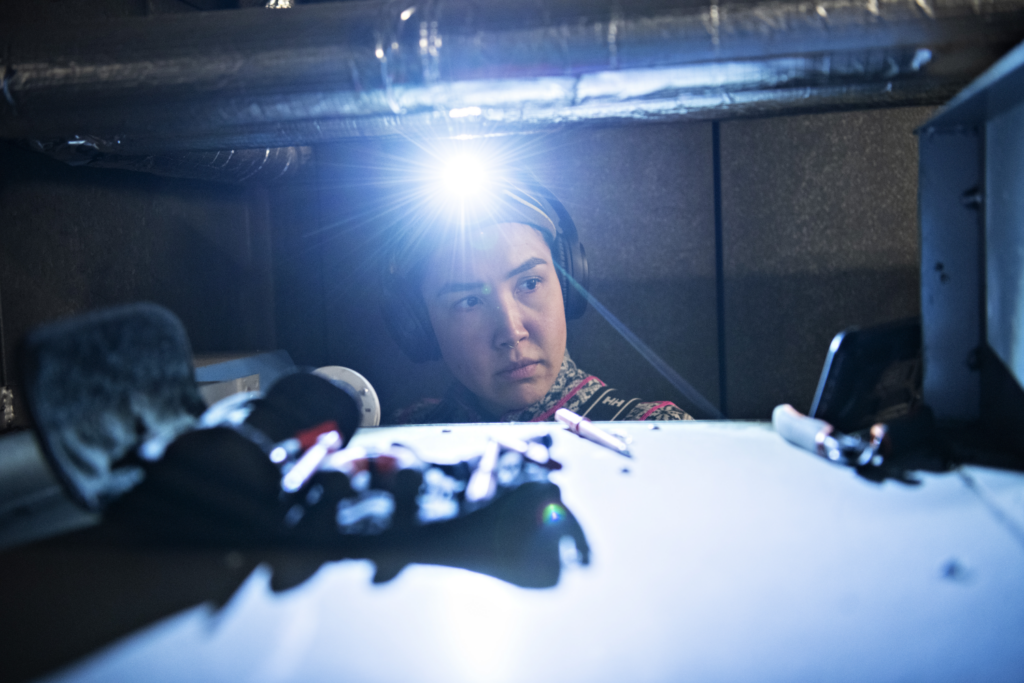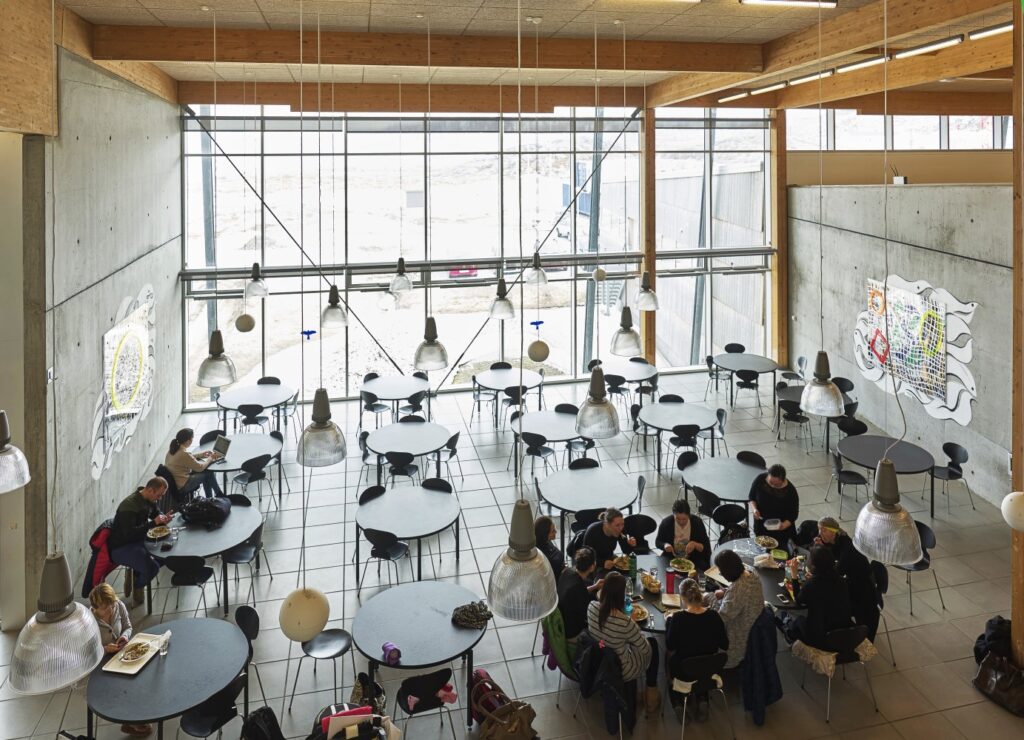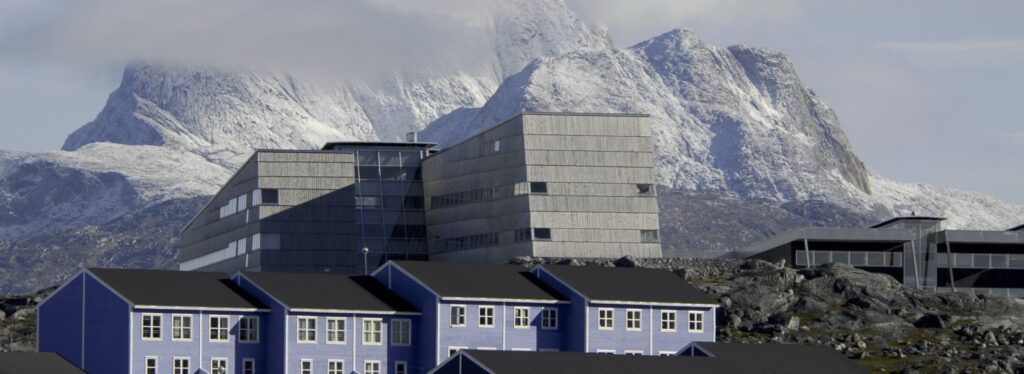
ANINGAAQ R. CARLSEN/VISIT GREENLAND, 2020
The proportion of the population aged between 16 and 74 who only have a primary and lower secondary school-leaving certificate after 10th grade was at 60 % in 2019. The general low level of education is, among other things, a reflection of the business structure in Greenland, where fishing and hunting have been, and still are, of great importance, both economically, culturally and historically. It can also be seen in how the level of education is distributed at municipal and national level. Towns and settlements that are located far away from Nuuk have a lower level of education. Kommuneqarfik Sermersooq, where Nuuk is located has, with 51 %, the lowest proportion of the population who only has the primary and lower secondary schoolleaving exam. Conversely, Avannaata Kommunia, with 71 %, has the highest proportion of the population whose longest completed education is primary and lower secondary school. The regional difference in education levels is also seen in relation to higher education. For people holding a bachelor’s, master’s and Ph.D. degree, Kommuneqarfik Sermersooq is at 18 % in 2019. At the other end of the education scale, Avannaata Kommunia is at 6 %.
In general, more women start on secondary and short vocational and higher education programmes, respectively, while more men start on the longer vocational education programmes.
Over the past ten years, the proportion of adolescents entering secondary education or vocational education programmes has been stable at around 40 % of a youth year group. This also means that around 60 % of adolescents do not continue in an education programme within the first two years of leaving primary and lower secondary school. The Self-Government’s goal is to bring that proportion down to 25 % by 2024.
Primary school education
In 2021, there were a total of 75 municipal primary schools in the five municipalities, one private school (in Nuuk) and one school for the hearing impaired (in Sisimiut). Children growing up on sheep farms in South Greenland are mostly homeschooled. The 75 municipal primary schools are distributed with 23 town schools and 52 settlement schools. In general, primary schools in the settlements are organised differently than schools in towns. Settlement schools are characterised by having fewer pupils, and classes with different year groups are taught together. For the small settlements, teaching in the settlement school ends after the 6th to 8th grade depending on the size of the school. Students are then required to move to the nearest town to finish primary and lower secondary school. Only three settlement schools have the necessary staff qualifications to allow students to finish grade 10 in the settlement. Some settlement schools send the children to town schools already after the 6th or 7th grade. Settlement schools often only have few teachers, of which some are not trained as teachers. Both trained teachers and untrained part-time teachers teach all subjects between the 1st grade and the 7th or 8th grade. In the 23 schools in the towns, classes are divided from 1st to 10th grade.
Since the introduction of home rule in 1979, there has been an increase in the number of trained teachers from the Teachers’ Training College, Ilinniarfissuaq, in the then Godthåb (now Nuuk), and out of the current almost 1,100 teacher positions in Greenland, about 90 are filled with teachers trained outside Greenland. 182 teachers work in primary and lower secondary schools without teaching qualifications and are employed as part-time teachers.
Between 2010 and 2019, there has been a 15 % decrease in the number of primary and lower secondary school pupils, in particular due to the small youth year groups, and in 2019, the overall number of pupils in primary and secondary schools was 7,499.
Over a period of more than ten years, both the National Education Authority and Statistics Greenland have documented a declining level in 10th-grade pupils’ school-leaving exams in all subjects. However, Greenlandic is an exception, where the level is stable. There is no clearcut correlation between settlement schools and urban schools and the pupil’s benefits from the teaching.
In 2017, the five municipalities entered into a collaboration on the development of the teachers’ didactic skills through the project Kivitsisa, meaning »Let’s elevate«. The goal of the project is bilateral: All teachers and pupils must have iPads, and teachers at all schools must take a course to upgrade their didactic qualifications. The aim of Kivitsisa is for more pupils to complete primary and lower secondary school with a better result. The Kivitsisa project, partially fund-financed and partially funded by municipalities, is expected to be fully implemented in 2024.
Youth education programmes

KÅRE HENDRIKSEN, 2015
In 1986, the Landsting (Inatsisartut) adopted the introduction of a threeyear high school education in Greenland. It was to be based on the Danish higher preparatory examination, and at the same time it should be possible to incorporate features from Greenlandic cultural life and identity. In 1996, the higher preparatory examination programmes were converted into GU (high school). The Landsting (Inatsisartut) decided in autumn 1997 to work to establish a technical high school (HTX). In 1999, a bill was passed to this effect, and the HTX programme enrolled the first students in 2000. As the last element within the field of education, the high school programmes were transferred to the Self-Government on 1 January 2009. Greenland now has four high schools, that in 2021, had the following number of students: Qaqortoq in Kommune Kujalleq 139 students, Nuuk in Kommuneqarfik Sermersooq 445 students, Sisimiut in Qeqqata Kommunia 171 students and Aasiaat in Kommune Qeqertalik 262 students. In addition, it is possible to complete high school as distance learning on the eGUX programme.
The completion rate of high school educations in 2019 was 48 % with an average age of 23. The large dropout rate originates in many factors, of which distance to the home is a significant one. In addition, the students’ social background, language skills and general academic skills are important.
43 % of the students who completed a high school education in 2017 commenced higher education within two years. This is a slight increase of 2 percentage points compared to the year group before. However, the proportion has been declining for a number of years, and a 32 percentage point decline can be seen compared to students from 2008 where 75 % commenced higher education within two years of graduating from high school.
18 % of the students who completed high school in 2017 continued on vocational education programme. Overall, the proportion who have started either higher education or vocational education within two years has dropped from 80 % (student year group 2008) to 61 % (year group 2017).
The decrease in the proportion continuing in higher education must be seen in the context of the number of students. The number of students completing the three-year high school programme in the period 2010‑14 increased by 56 %, while the number who commenced higher education programmes was on par with previous years.
Student numbers have been increasing with 347 starting on education programmes in 2005 and 500 in 2019. In 2005, 150 completed high school; by 2019 the number had increased to 314.
Vocational education programmes

LARS O. DEMAND-POORT, 2020
Vocational education programmes in Greenland is a practical education aimed at a particular trade. For example, this could be engineering, office work or offshore work. In Greenland, a total of 67 different vocational education programmes are offered.
The average age at completion was 30 years in 2019. What characterise these education programmes is that they are alternating programmes, i.e. alternating between theoretical school stays and practical training. A large part of the education programmes can be completed in Greenland, but there are also programmes that require school stays in Denmark.
The vocational education programmes range widely in relation to the official period of study, and the statistics are therefore divided into short vocational education programmes lasting from about six months to two years, and general vocational education programmes that last at least two years. 63 % of the students who started on a short vocational education programme in 2015 completed the programme within two years. After another two years, 65 % had completed the programme.

In the general vocational education programmes, which last at last two years, the completion rate is lower. Within four years, 36 % had completed the programme they began in 2012. After six years, 42 % had completed the programme. The number of students has been increasing with 566 commencing programmes in 2005 and 795 in 2019. In 2005, 269 finished a vocational education programme; by 2019 it had risen to 449.
The engineering programmes are gathered at Kalaallit Nunaanni Teknikimik Ilinniarfik (KTI), headquartered in Sisimiut, where also the building and construction programmes, Sanaartornermik Ilinniarfik, and the school of minerals & petroleum, Aatsitassarsiornermik Ilinniarfik, are housed, while Tech College Greenland, Saviminilermik Ilinniarfik, is located in Nuuk.
The business school, Niuernermik Ilinniarfik, has departments in Nuuk and Qaqortoq, and similarly, Imarsiornermik Ilinniarfik (Greenland Maritime Centre) has departments in Nuuk and Paamiut, while the food education programmes are gathered at INUILI in Narsaq.
Higher education programmes

ULRIK BANG/ILISIMATUSARFIK, 2016
The first education programme in Greenland besides primary and lower secondary school was the teacher/catechesis training at Ilinniarfissuaq, established in 1847 in Nuuk and in 1848 in Ilulissat. For more than 100 years, until the establishment of the Ilisimatusarfik/Inuit Institute in 1984 (renamed Ilisimatusarfik/University of Greenland in 1987), teacher training was the highest education available in Greenland.
In 1974, teacher training was joined by the training programme to become a social education worker. In 1995, the training programme, under the name Perorsaanermik Ilinniarfik/College of Social Education, PI/SPS, moved from Nuuk to Ilulissat. In addition to the education programme for social worker at bachelor level, PI/SPS provides four other vocational education programmes aimed at social work. 58 % of those enrolled complete social worker programme.
Ilisimatusarfik/University of Greenland provided the first master’s degree programmes in 1987. The new university park, Ilimmarfik, which has the Greenland Institute of Natural Resources as its nearest neighbour, was inaugurated in 2008. Today there are four institutes at Ilisimatusarfik: The Institute of Society, Economics & Journalism, the Institute of Culture, Language and History, the Institute of Health & Nature and the Institute of Learning. Each institute has a number of departments, and together the four institutes cover over ten departments. In addition, a PhD school has been established. A planned bachelor programme in Arctic biology in 2021 has not yet obtained funding.
The number of enrolled students at Ilisimatusarfik has increased over the past ten years; from around 500 students in 2009 to about 700 in 2019.
In addition to Ilisimatusarfik, it is possible to take higher education in Sisimiut where the Technical University of Denmark (DTU), in cooperation with Greenland’s Self-Government, offers a four-year BSc programme at the Centre of Arctic Technology (Artek), which accepts students from both Greenland and Denmark. The first 18 months takes place in Sisimiut, and a six-month internship and the six-month final project usually takes place in Greenland or alternatively somewhere else in the Arctic. The remaining 18 months takes place in Denmark. Since the start-up of Artek in 2001, 135 bachelors of Arctic engineering have graduated from the programme, including 56 who have completed high school in Greenland. 68 graduates worked in Greenland in 2020, including 50 who have completed high school in Greenland.
Pinngortitaleriffik, the Greenland Institute of Natural Resources, primarily a research institution, has been providing master’s programmes for biology students through the Arctic Science Study Programme, ASSP, since 2015. Since its start-up in 2015 to autumn 2021, 158 students have completed the programme. Graduate students at ASSP primarily come from universities outside of Greenland, as a BSc degree in natural sciences had not yet been established in 2021.
Further reading
- Health and care
- Hunting and subsistence economy
- Industry and labour market
- Infrastructure
- Language
- Nuuk
- Plans in Greenland
- Population and demographics
- Self-Government
- The five regional municipalities
- The Greenlandic insular community
- The Unity of the Realm and the Danish State
- Towns and settlements
Read more about Society and business in Greenland

